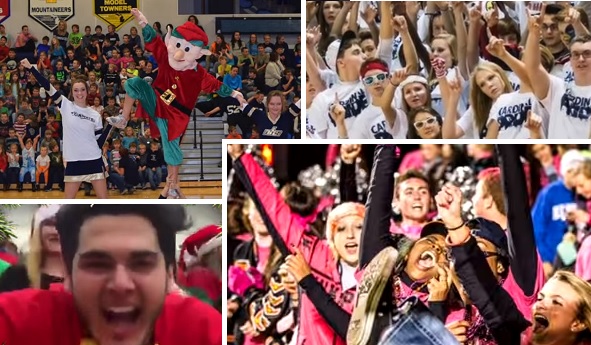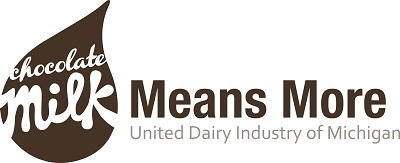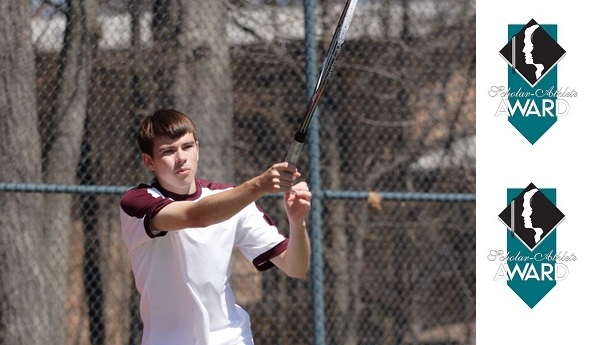
BOTF V: What You Taught Us
February 17, 2016
By Geoff Kimmerly
Second Half editor
We’ve completed our Battle of the Fans statewide tour for 2016, and hopefully you’ve kept up with our visits and learned why our five finalists are candidates to be known as the state’s top high school student section.
 But we appreciate as well the great student sections that entered the contest and weren’t chosen this time for the finalists tour. We try to teach sportsmanship and the best way to support your local teams – but all of our applicants taught us something again this winter.
But we appreciate as well the great student sections that entered the contest and weren’t chosen this time for the finalists tour. We try to teach sportsmanship and the best way to support your local teams – but all of our applicants taught us something again this winter.
Here’s a look at what we learned from the 17 student sections who didn’t make the BOTF Finals, but should be celebrated as well:
Tradition never graduates
Ann Arbor Gabriel Richard’s video took us through five years of its student section. The Fighting Irish were a BOTF finalist in 2013, and the section brings a strong effort every year although a new class of students joins each fall and a veteran group of leaders graduate each spring. Longevity and doing it right earns a lot of respect – not only from us, but surely in the community as well as the section has become such a prominent and positive part of student life at the school.
Get inspired
The Saginaw Michigan Lutheran Seminary student section was represented in a local contest last year by a photo of a few students sitting in the bleachers. Things had to change. Driven by the student council and a league Sportsmanship Summit, the Superfans were born – in fact, superfan became a verb to mean taking part. They’re off to a great start.
Wyoming Godwin Heights’ “Fred’s Fanatic Fans” also got their start this year as part of the Promote Enthusiastic Price (P.E.P.) Club, which was created to cheer on the school’s teams and “build the right climate.” We couldn’t have described the right goal better ourselves.
St. Johns was a finalist in 2015 even as leaders were still working to sway the entire student body toward a new, positive way of thinking and cheering. That movement continued to pay off this year; the Redwings were back, bigger and better, and we were glad to see it.
Be proud
Big Rapids has a few more than 600 students, but we could count at least 150 making up a rowdy crowd at a number of events used in the application video. Everything we could see pointed toward what has to be a blast in the stands.
 Fulton literally spelled out its drive on the screen: “Small Town, Small Teams, Big Hearts, Big Dreams.” The school has 200 students – and like finalist Munising, showed it can be done, filling the stands for a variety of games used in the video.
Fulton literally spelled out its drive on the screen: “Small Town, Small Teams, Big Hearts, Big Dreams.” The school has 200 students – and like finalist Munising, showed it can be done, filling the stands for a variety of games used in the video.
Manton’s Ranger Rowdies may number no more than 280 students, but they certainly bring the noise, literally, which was immediately obvious. Most of the student body had to be in attendance for the games they filmed.
Follow the leaders
Similar to finalist Traverse City West, Detroit U-D Jesuit’s section is driven by its student government. A student senate committee is dedicated to making the section (and whoever came up with the wrecking ball deserves a few more votes in the next election).
We know about the strength of Dowagiac’s leadership firsthand after awarding the section the BOTF 2015 championship. They had a lot of leaders showing the way last year, and that appeared to be true again – a favorite part was a line of students arm-in-arm in the front row, facing the rest of the section during a back-and-forth cheer. And the The Attack's chant shown below always will be a favorite.
Be creative
Tawas’ Brave Cave is full of ideas, starting with in-game interviews of students during an application “broadcast” by TSPN (Tawas Sports Programming Network). Tawas Proud, indeed, and for good reason.
Even if the “D” was upside-down at first on the line of placards spelling out the school’s name in the back row (which was funny), Wayland brought plenty to join the discussion of possible finalists. The “Den” was filled with costumes, signs, and just a lot of material that surely makes for a fun night.
For starters, Pontiac Notre Dame’s name – Irish Thunder – just sounds powerful. It was hard to tell what was going on as part of the “Whistle Cheer,” but it looked pretty wild, especially in front of what appeared to be a giant pep rally crowd (See below).
Involve everyone
Walled Lake Western’s video included interviews with parents and basketball players as well, and one of the athletes said something that especially stuck out: “They cheer the other team and us on.” That’s taking inclusion to another level, and we applaud it.
Utica Ford’s leaders spoke during its application about how the student section was like something bigger than the school itself – something they all have together. And that’s a great thing. (The student section flag was a cool touch as well.)
Holland’s Dutch Nation leaders take getting everyone involved to the highest level, incorporating the pep band and cheerleaders during games and the athletic director and many others at the school behind the scenes. As one said, “We work to spread participation not only for the students, but the whole community.”
Imlay City’s Spartan Nation made shirts like many student sections, but didn’t reserve them for high school students alone – they made them for elementary and middle schoolers and sold to the greater community as well in an effort to get everyone together. (And bringing in Santa Claus for a Christmas-themed game for the younger kids was a neat idea too.)
Ending on one last strong note, we hope Norway is just beginning its BOTF quest. #UKNIGHTED might be the best campaign of BOTF V. They’re “all knights and all united,” and set a great example of getting a community together.
Click to watch all 22 application videos for this year's Battle of the Fans V.

Goorhouse Gives Back at Home
By
Geoff Kimmerly
MHSAA.com senior editor
January 24, 2014
By Geoff Kimmerly
Second Half editor
Three traits have been key in making Holland Christian grad Mike Goorhouse nationally-recognized as a civic leader on the rise.
He’s a strong communicator, which comes in handy when coordinating support for causes all over the state.
He’s a relationship builder, allowing him to develop strong rapport as he explains how everyone can give something back to their communities.
 Finally, Goorhouse is a philanthropist – not just in job, but in life. He is the vice president for donor development at the Community Foundation of the Holland/Zeeland Area, where he works to raise support for nonprofit organizations. He also has served on the boards of directors/trustees for eight organizations, and he and his wife financially contribute to more than 15.
Finally, Goorhouse is a philanthropist – not just in job, but in life. He is the vice president for donor development at the Community Foundation of the Holland/Zeeland Area, where he works to raise support for nonprofit organizations. He also has served on the boards of directors/trustees for eight organizations, and he and his wife financially contribute to more than 15.
But a fourth quality, nurtured during his tennis and soccer careers, has been an asset as well for the 2003-04 MHSAA Scholar-Athlete Award winner.
“I always loved the competition side of sports. I talk to people who own companies, run companies, run shops. The reason they hire people who were involved in athletics is because of that drive,” said Goorhouse, 27, who was named in 2011 as one of the top 30 civic leaders nationally under the age of 30 by online networking site Splashlife. “Not everyone has that drive to succeed, to win, get a goal.
“Succeeding in the non-profit world looks a lot different. But it takes the same drive.”
 Goorhouse was among scholar-athletes recognized during the winter of 2004 by the MHSAA and Farm Bureau Insurance, which continues to sponsor the Scholar-Athlete Award program that has grown to honor 32 recipients annually. In advance of this March’s 25th celebration, Second Half is catching up with some of the hundreds who have been recognized (see additional links at the bottom of this page).
Goorhouse was among scholar-athletes recognized during the winter of 2004 by the MHSAA and Farm Bureau Insurance, which continues to sponsor the Scholar-Athlete Award program that has grown to honor 32 recipients annually. In advance of this March’s 25th celebration, Second Half is catching up with some of the hundreds who have been recognized (see additional links at the bottom of this page).
Earning a Scholar-Athlete Award likely meant more to Goorhouse than many of the other 607 who have been recognized over the quarter century. His grandfather, father and brother all have served as MHSAA officials, and his dad and brother both coach as well.
Mike also is part of a third generation of Goorhouses who annually attend the MHSAA Boys Basketball Finals, during which the Scholar-Athlete winners are recognized. He joined his dad and grandfather starting at 8 or 9 years old, and every year would read the bios of Scholar-Athlete Award winners in the Finals program and watch them line up on the court during halftime of the Class C championship game.
“Honestly, I wanted to be that,” Goorhouse said. “I had a lot of respect for the ability to balance academics and sports, and be good at both."
Goorhouse won the MHSAA Lower Peninsula Division 3 tennis title at No. 4 singles as a sophomore in 2002 and returned to the Finals at the No. 1 flight as a senior. He also played soccer at Holland Christian and then played tennis at Calvin College.
Tennis exposed Goorhouse to handling pressure on an individual basis while building mental toughness. Soccer was more about blending teammates’ skills and developing communication among the group.
“Everyone has his or her own version of the story, and that makes it more true; sports teaches a lot about leadership, and just about life and navigating the ups and downs, emotions, handling yourself under stress,” Goorhouse said. “I was in two way different sports, and it was fun to be able to see how those two things impacted me differently.”
As high school students begin focusing on college and potential occupations, professional giver probably isn’t an option many realize is possible. Goorhouse would’ve been counted in that group while at Holland Christian until becoming a member of the Community Foundation’s Youth Advisory Council. That opportunity joined him with many of his sports opponents from around the Holland area as they assisted the foundation in grant making for youth causes.
The philanthropy bug stuck. After his freshman year at Calvin, Goorhouse interned with the statewide Council of Michigan Foundations, which then hired him parttime as a college sophomore and fulltime once he graduated.
He returned to the Community Foundation in 2012 and works with 1,500 donors who contribute to the Holland/Zeeland area.
As donations grow, so does the foundation’s ability to give grants. But it’s not all about money. An oft-quoted definition of philanthropy is the “giving of time, talent and treasure” – and Goorhouse, as he speaks to various groups, makes sure to emphasize “and” as the most important word of that statement while encouraging donors to give of themselves in all three ways.
“It’s who I am as a person that fits this job so perfectly. It’s hardly work,” Goorhouse said. “When they’re thinking about giving back to the community, they’re at their best. I get to talk about what they care about.”
Goorhouse earned his bachelor’s degree in secondary education and then a master’s in public administration from Grand Valley State University. He’s able to take advantage of his relative youth in the professional world to connect with high school students and explain to them the opportunities to give back as part of the non-profit world. He serves on the boards of generationOn and Learning to Give, which both focus on integrating service into pre-college education.
While the national recognition in 2011 might’ve carried the most significance among honors Goorhouse has received, another he earned in 2009 has been his most meaningful on a personal level.
He was honored with the inaugural Young Philanthropist of the Year award by the Community Foundation. He didn't begin work for that organization until three years later, but giving back in his hometown always has been close to his heart.
“I love this place. It’s not that I can only do this work here, but it’s extra special to do the work you love in the place that you love,” Goorhouse said. “I could’ve lived anywhere because I would be on the road regardless. But to come home where my family and friends are, to the community I know best, it’s special.”
Click to read the series' first installments:
- 25 Years Later, Scholar Athletes Shine On
- On Call as Doctor, Director, Mom
- "Mailloux Management" Goes Global
PHOTO: Mike Goorhouse sends a volley while playing tennis for Holland Christian. He won an MHSAA Scholar-Athlete Award in 2004. VIDEO: Goorhouse speaks in 2004 about playing for his high school tennis coach John Knoester.

